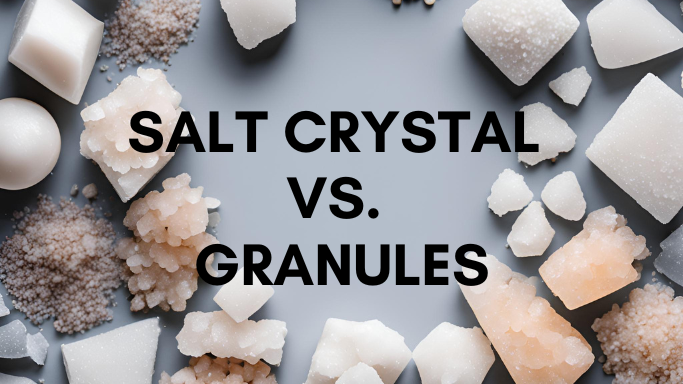Salt is an essential ingredient in cooking, but it’s not just about seasoning your food—it’s also about texture, flavor, and presentation. Salt comes in different forms, with salt crystals and granules being two of the most popular. Although they may seem interchangeable, they each offer unique characteristics that can impact the outcome of your dishes. Let’s dive into the differences and figure out when to use each type of salt for optimal results.
What Are Salt Crystals?
Salt crystals are larger, irregularly shaped chunks of salt that are typically harvested from salt mines or seawater. These crystals are less refined and often have a more natural appearance. Because of their larger size, they have a coarser texture compared to granules.
Characteristics of Salt Crystals:
- Texture: Rough, chunky, and unevenly shaped.
- Taste: The flavor is often more subtle, providing a less intense saltiness due to the larger surface area.
- Uses: Ideal for finishing dishes, providing a satisfying crunch and burst of flavor on foods like grilled meats, roasted vegetables, or caramel desserts. They're also great for salt crusts or baking applications where a rough texture is desired.
Common types of salt crystals include kosher salt, Himalayan pink salt, and Fleur de Sel.
What Are Salt Granules?
Salt granules are smaller, more uniform particles of salt. They are typically processed from mined or evaporated salt and are ground into fine or medium-sized grains. Table salt is an example of granulated salt, and it’s often iodized to provide essential nutrients.
Characteristics of Salt Granules:
- Texture: Fine to medium-sized grains that dissolve easily in liquids and on food.
- Taste: More intense, providing a sharper saltiness than crystals due to the higher surface area relative to volume.
- Uses: Granules are ideal for seasoning during cooking and baking, where even distribution of salt is important. Granulated salt is also commonly used for pickling, preserving, and making brines. Its finer texture ensures it integrates smoothly into dishes.
Table salt and sea salt granules are among the most commonly used granulated salts.
Key Differences Between Salt Crystals and Granules
-
Size and Texture:
- Salt crystals are large and irregular, providing a crunchy texture that stands out on the surface of dishes.
- Salt granules are smaller and more uniform, easily dissolving and dispersing throughout the dish for a more consistent seasoning.
-
Flavor Impact:
- The larger crystals give a milder, more subtle flavor. They provide an initial burst of saltiness when you bite into them, making them ideal for finishing.
- Granules, due to their fine nature, dissolve quickly and provide a more uniform, pronounced saltiness, which is excellent for cooking and baking.
-
Dissolution:
- Crystals dissolve more slowly, making them ideal for finishing touches where you want the texture and visual appeal of salt to be noticeable.
- Granules dissolve faster, making them better for recipes where the salt needs to be integrated throughout.
When to Use Salt Crystals
-
Finishing Dishes: Because of their large size and delicate crunch, salt crystals are perfect for sprinkling on dishes just before serving. They are often used to enhance the visual appeal and provide a burst of flavor in the final bite. For example, you might sprinkle a pinch of Himalayan pink salt or Fleur de Sel over a chocolate cake or freshly grilled steak.
-
Seasoning Meats: Crystals like kosher salt are commonly used in meat preparation. Their coarse texture helps with even seasoning and can form a flavorful crust on meat when used for dry brining.
-
Baking: Crystals are often used in bread-making to create texture on the crust, or on top of soft pretzels and bagels, where you want the crunch to stand out.
-
Pickling and Curing: Crystals are also used in some pickling and curing processes where the salt is used to draw out moisture from foods.
When to Use Salt Granules
-
Baking and Cooking: Granulated salts like table salt or fine sea salt are better for mixing into doughs, batters, and sauces where a uniform distribution of salt is necessary. Granules dissolve quickly, ensuring that the salt is evenly distributed throughout the mixture.
-
Cooking Soups, Sauces, and Stews: When making soups, sauces, or stews, granules work best because they dissolve rapidly and evenly distribute the salt throughout the dish. This is especially important in dishes with a lot of liquid, where you want to ensure the salt is fully integrated.
-
Pickling: Salt granules dissolve easily, making them ideal for quick pickling and brining solutions. Their fine texture ensures they blend well with water, vinegar, and other ingredients used in the pickling process.
-
Seasoning While Cooking: For seasoning while cooking, granules ensure an even distribution, making it easier to adjust the saltiness to your liking during the cooking process.
Substituting Salt Crystals and Granules
If you’re in a pinch and only have one type of salt, you can substitute salt crystals for granules and vice versa, but keep in mind that you may need to adjust the quantity. Since crystals are larger and airier, you’ll need more of them to match the saltiness of granules. For example, 1 teaspoon of salt granules equals about 1 1/2 teaspoons of salt crystals.
Conclusion
Salt crystals and granules each have their specific purposes in cooking and baking, and choosing the right one depends on the texture, flavor, and dissolution rate you need in your dish. Salt crystals are perfect for finishing touches and adding crunch, while granules work best for evenly seasoning dishes during cooking or baking. Understanding the differences between these two forms of salt and knowing when to use each will help you achieve better flavor, texture, and consistency in your culinary creations.




